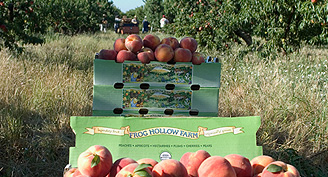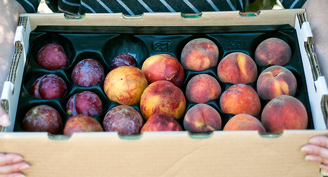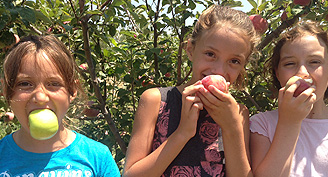This Week's Fruit
Apache Apricots Frog Hollow Farm, Brentwood, CA The Apache is one of the newest varieties of apricots introduced to growers and was developed by the USDA Agricultural Research Service. It’s early off the tree, and like our Brooks cherries, doesn’t sacrifice any flavor or texture to beat its more popular cousins off the branch. Apache’s skin is pinkish-orange, with an orange flesh that is finely textured. Rich Zee Peaches Frog Hollow Farm, Brentwood, CA The Rich Zee is an excellent early variety to wet the appetite for summer peaches. It is much smaller than later varieties, and is more of a water peach than a sugar peach, but a big pleaser due to its early arrival. Rich Zee has a strong fragrance, a subtle flavor, and tender juicy flesh. Pink Lady Apples Cayuma Orchards, New Cayuma, CA A cross between the Golden Delicious and Lady Williams, the Pink Lady is a crisp and juicy apple with a tart finish. Pink skins and a creamy white colored flesh that resists browning makes this an excellent apple for salads and slicing. Hayward Kiwi Chiechi Farms, Live Oak, CA Originally known as the Chinese gooseberry due to its Chinese orgins. Hawyward Wright, a New Zealand nurseryman propagated his plants by grafting and they eventually became the preferred cultivar of growers due to their sweet flavor and thin skin.A Note from Farmer Al
Dear CSA Members, Bacteria Rule the Earth So, on April 25th doctors removed an abscess in my left tibia. This infection was a “flare-up” of bacteroides fragilis, which is an anaerobic bacterium that had been dormant in my leg for 30 years, following a major car accident injury in July, 1981. They actually physically removed the bacteria, with scalpels, etc., but just to be sure, I will be on local antibiotics for another 5-6 weeks to make sure all the persistent little guys are eradicated, finally! Meanwhile, here on the farm we are doing our best to GROW bacteria by the trillions in our compost and then AMPLIFY them to even more staggering numbers in our compost tea. All these are GOOD GUYS of course and will greatly enhance the health and productivity of our soil and our whole farm ECOSYSTEM. Our goal: to grow fruit even sweeter than it already is. To explain one important aspect of this process in the soil, I asked Christophe the question; “How is nitrogen cycled by protozoa?” Here is his answer: • Protozoa control bacterial populations by eating them: they require carbon, nitrogen and other nutrients (phosphorus, calcium, magnesium etc..) Carbon is needed to provide energy (eating sugar releases energy) and nitrogen is needed for the biosynthesis of various molecules (such as proteins) • The ratio of carbon to nitrogen in bacteria is 5:1. The ratio of carbon to nitrogen in protozoa is 30:1 (in humans the ratio is the same; we all know that it can be higher around the waistline when we don't watch our diet). This means that bacteria are bags of fertilizer. However plants don't eat bacteria. • (Note on C:N ratios. In reality, all organic matter (including bacteria and people) has about the same amount of carbon (54%) but differs in the amounts of nitrogen (more or less). However, for simplicity's sake, nitrogen is assigned a value of 1) (Other carbon ratios: carbon to phosphorus 75:1 -250:1; carbon to potassium 100:1-150:1; carbon to sulfur 100:1 and higher) How does nitrogen get from bacteria to plants • A flagellate (a type of protozoan that propels itself in soil, compost and compost tea with the aid of a hair-like structure called a flagellum) needs to eat 6 bacteria to obtain 30 carbons per unit biomass. That means that it eats 5 nitrogens too many. This has to be excreted. • Each flagellate eats 10000 bacteria per day: 8000 molecules of nitrogen are released • In an average soil, there are 50,000 protozoa per gram of soil • This means that flagellates eat 500,000,000 bacteria per day per gram of soil • This means that 400,000,000 molecules of nitrogen are produced per gram of soil per day • Protozoa hang around the roots most of the time (see email on exudates): a gram of soil covers about 1 cm3 of soil • 400,000,000 molecules of nitrogen weigh 7 nanograms (1/12 of a gram). So, 7 nanograms of nitrogen per cm3 of root are available to a plant. • However, on average plants require only 0,2 nanograms of nitrogen per cm3 of roots per day. There is plenty of nitrogen in the right chemical form available to plants • The excess nitrogen is recycled through the soil food web • This example reflects only one part of the soil food web system and illustrates in a simplistic way a complex and well regulated ecosystem under our feet







